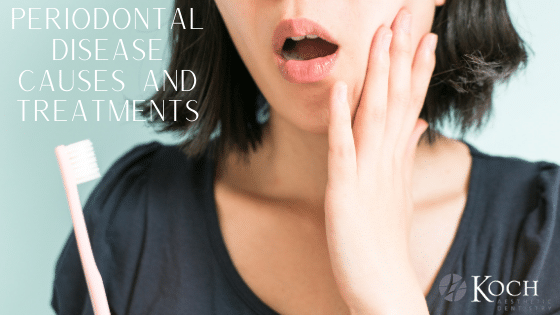
02 Apr Periodontal Disease Causes and Treatments
Periodontitis is a common gum disease that causes swelling, soreness, and infection to the soft tissue supporting the teeth. If left untreated, periodontitis can cause serious problems like destruction of the bone supporting the teeth, loosening of the teeth, and even tooth loss. Although periodontitis is common, it can be prevented by proper dental care and regular examinations. Here is what you need to know about periodontal disease and how to prevent it.
Periodontal Disease Overview and Causes
Healthy gums are usually firm, pale pink, and fit tightly around the teeth. If you start noticing inflamed or bleeding gums, you might be suffering from a gum disease called periodontitis. In which case, you are not alone – an estimated 42% of Americans over the age of 30 experience this gum disease.
Gum disease has multiple levels of severity. Early stages include gingivitis which is the type of infection that affects only the gums and may cause inflammation and bleeding. Gingivitis is easily treatable, but if left unchecked, it can progress to periodontitis and cause the gums to pull away from the tooth, bone loss, and even tooth loss.
Symptoms of periodontal disease usually include:
- Swollen or puffy gums
- Bad breath
- Loose teeth or loss of teeth
- Painful chewing
- Puss between teeth and gums
- Gums that bleed easily
- Receding gums
- Gums that feel tender to the touch
What Causes Periodontal Disease?
Bacteria from dental plaque, poor oral hygiene, and toxins produced by bacteria can all cause periodontal disease. The American Academy of Periodontology (AAP) states that plaque can spread below the gum line if left untreated. The toxins present in the plaque can irritate your gums and, in some cases, cause your body to break down the tissues that support the teeth.
Eventually, the gums will begin to pull away from the teeth, forming periodontal pockets. When the periodontal pockets, or spaces between the tooth and the gum, become infected – they can destroy even more soft tissue and bone.
Periodontal Disease Treatment
Your dentist will recommend the best treatment plan depending on your diagnosis and the severity of the disease. Some treatments for periodontal disease are:
Scaling and Root Planing
Scaling and deep cleaning techniques can help remove plaque from the teeth above and below the gum line. Root planning can remove plaque from the root’s surfaces and address uneven spots that trap and hold bacteria.
Periodontal Gum Surgery
If the pockets around the gums are so deep that the dentist can’t clean them with non-surgical methods, your dentist may recommend periodontal gum surgery. In periodontal gum surgery, the periodontist will make small incisions in the gums and flap them back to better access the roots. The periodontist can then perform scaling and root planing.
Gum Graft Surgery
If the gums begin to recede due to periodontal disease, it might be necessary to perform a gum graft. Gum graft surgery reshapes gums or grafts new tissue over exposed tooth roots.
Periodontal Disease Prevention
The best way to address periodontal disease is to catch it before it begins. Practicing good oral hygiene is an important step in preventing periodontal disease. Good oral hygiene includes regular twice-daily brushing and nightly flossing.
In addition to practicing good oral hygiene, it is essential to make regular visits to your dentist. Getting a professional cleaning every 6 to 12 months can greatly reduce the chances of developing periodontal disease and keep your gums healthy and happy.
Learn more about periodontal disease treatment at Koch Aesthetic Dentistry
At Koch Aesthetic Dentistry, we go out of our way to make sure your dental experience is pleasant and that you leave looking and feeling better than when you came in. If you’d like to learn more about our periodontal disease treatment and the expert care we provide, contact us today.


